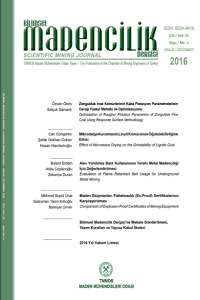Enhancing the bearing capacity of friction anchor bolts through cementitious concrete injection for reinforced support in underground mine
Enhancing the bearing capacity of friction anchor bolts through cementitious concrete injection for reinforced support in underground mine
___
- Aziz, N., Majoor, D., & Mirzaghorbanali, A. (2017). Strength properties of grout for strata reinforcement. Procedia engineering, 191, 1178-1184.
- Barton, N., Løset, F., Lien, R., & Lunde, J. (1981). Application of Q-system in design decisions concerning dimensions and appropriate support for underground installations. In Subsurface space (pp. 553-561). Bieniawski, Z. T. (1973). Engineering classification of jointed rock masses. Civil Engineering= Siviele Ingenieurswese,(12), 335-343.
- Bieniawski, Z. (1988). The rock mass rating (RMR) system (geomechanics classification) in engineering practice. In Rock Classification Systems for Engineering Purposes. ASTM International. Kılıc, A., Yasar, E., & Celik, A. G. (2002) Effect of grout properties on the pull-out load capacity of fully grouted rock bolt. Tunnelling and underground space technology, ;17(4), 355-362.
- Komurlu, E., & Demir, S. (2019). Length effect on load bearing capacities of friction rock bolts. Periodica Polytechnica-Civil Engineering, 63(3).
- Li, C. C. (2017) Principles of rockbolting design. Journal of Rock Mechanics and Geotechnical Engineering; 9(3), 396-414.
- Li, S. C., Wang, H. T., Wang, Q., Jiang, B., Wang, F. Q., Guo, N. B., ... & Ren, Y. X. (2016) Failure mechanism of bolting support and high-strength bolt-grouting technology for deep and soft surrounding rock with high stress. Journal of Central South University;23(2), 440-448. Liu, J., Li, H., Li, Y., Yang, Y., Sun, T., Song, R., & Sun, R. (2021) Study on the Effect of Isotropic Initial Stress on the Anchoring Performance of Self-Expanding Bolts. Advances in Civil Engineering; 1-19. Wong, H. S., Zobel, M., Buenfeld, N. R., & Zimmerman, R. W. (2009). Influence of the interfacial transition zone and microcracking on the diffusivity, permeability and sorptivity of cement-based materials after drying. Magazine of concrete research, 61(8), 571-589. Zhang, Y., Li, X., & Liu, Y. (2017): Numerical simulation of the effect of water-cement ratio on the pull-out resistance of fully grouted rock bolts. Advances in Civil Engineering .
- ISSN: 2564-7024
- Başlangıç: 1960
- Yayıncı: TMMOB Maden Mühendisleri Odası
Hüseyin Onur DÖNMEZ, Hakan TUNÇDEMİR
Dust Pollution Characteristics and Control Measures of Open Pit Coal Mine
Sair KAHRAMAN, Masoud ROSTAMİ, Behnaz DİBAVAR
Utilization of wastes/by-products as a grinding additive
Serkan ÇAYIRLI, Hasan Serkan GÖKÇEN, Nuri YÜCE, Obaidullah ELCHİ
